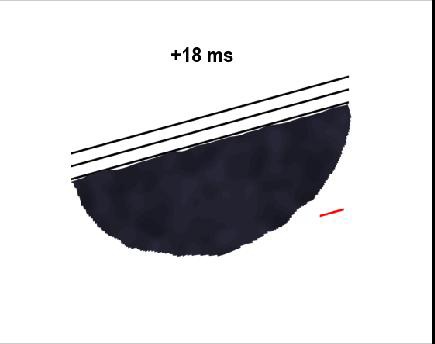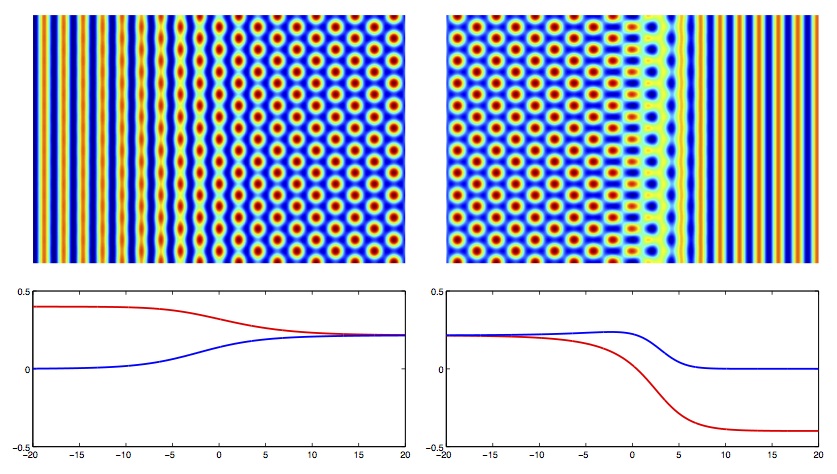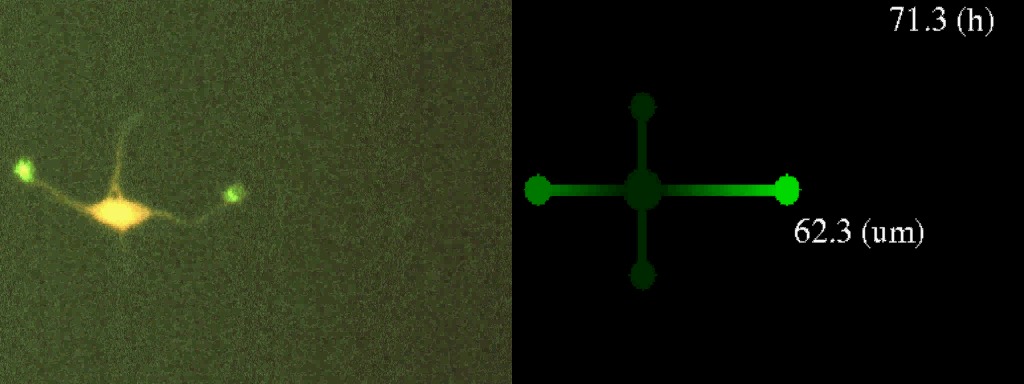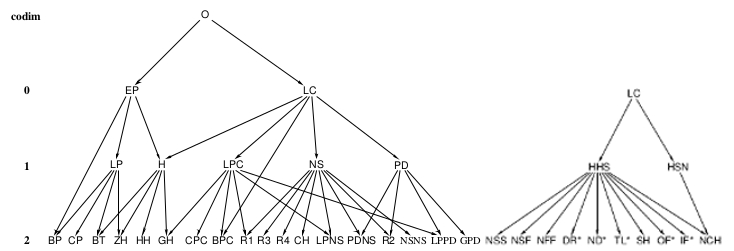The track organised by the Activity Group on Dynamical Systems comprised six topics: experimental nonlinear dynamics,
equivariant dynamics in biological systems, numerical analysis, rigorous computation, application of topological ideas
and stochastic dynamics. Each topic was represented by four speakers in a minisymposium, with the exception of
experimental nonlinear dynamics, which spanned two mini-symposia and the plenary address by Katharina Krischer.
Although all sessions ran in parallel with several others, including the track organised by our geophysical
colleagues, attendance was good throughout. A number of dynamical-systems-flavoured minisymposia and contributed
sessions were also on the menu, but in this report I will focus on the six topics listed above.
Originally, Network Dynamics was planned as a seventh topic, but SIAM vetoed my joint proposal with the
organisers of the satellite workshop on Networks to cross-list their session on dynamics. They cited the fact that
workshop participants had paid for access to the Annual Meeting, but not the other way around. A disappointingly
narrow-minded stance in my personal opinion, but I could not avoid session
MS22 being listed as "cancelled."
The opening session of our track was the first part of Nonlinear Experimental Dynamics, organised by Eberhard
Bodenschatz, with the second part closing the meeting on Friday afternoon. Each of the speakers on this
topic discussed an experiment involving nonlinear dynamics, but the systems under consideration could hardly
be more diverse.
The first speaker was Stefan Luther, who discussed the delivery of electrical shocks that stop cardiac
arrhythmia using a much lower voltage than conventional defibrillators. Conventional defibrillators, while
successful in restarting the healthy heart rhythm, cause pain and do damage to the heart tissue.
The novel approach is to
deliver smaller shocks to the heart to terminate spiral waves of electrical activity. Using an array of measurements of the activity on the heart's
surface as well as in its interior, Stefan and his colleagues managed to design a device that can deliver
targeted shocks. The success rate of this approach is not quite as high as that of the brute-force method,
but he hopes that the targeted approach will become the option the paramedics will attempt first.
Karen Daniels described the formation of cracks
in soft media caused by drops of fluid. Although the spreading of droplets on hard matter, such as water
on glass, and in fluids, such as oil in water, are well-studied, the reaction of soft materials
is largely unexplored. Unique to this setup is the formation of fractures, i.e., sharp
indentures in the substrate. Karen derived a scaling law for the number of such fractures emanating
from a droplet as a function of such material properties as the surface tension and viscosity of the liquid and the
substrate and showed that it matched experimental data well.
Nicolas Mordant had an audio track with his presentation: the sound of a thunder sheet, a thin, suspended, metal sheet that exhibits decaying wave turbulence. The quantity of
interest is the power spectrum of the waves. Classical statistical theory leads to the "Kolmogorov-Sakharov"
spectrum, but measured spectra deviate significantly from this prediction. The assumption at fault
appears to be that dissipation is present only at high wave numbers. The approximation can be improved
to include dissipation throughout the spectrum, and in that case the measurements
are reproduced.

An individual trial of the experiment Lyle Muller described, showing the activation of the visual cortex of a live, awake monkey, reacting to a visual simulus. Movie by Lyle Muller
Nick Gravish
is trying to find out how honey bees ventilate their hives. The species he is interested in lives in hollow trees, allowing only for a single long and thin opening. The temperature inside must
remain between 33 and 36 degrees and the CO2 concentration must likewise be controlled. To this end,
dedicated "fanners" line up at one side of the entrance and produce an air flow with their wings.
Nick's experiments are aimed at understanding both the dynamics of the fanning itself and the communication
needed to control the process. As an example of the first objective, he measured the forces on, and air flow
generated by, "robot wings." A simple experiment with the communication
between bees was to move a number of fanners to the other side of the entrance, making two groups
work against each other. After a few minutes, the majority wins and the stray fanners return.
Eberhard Bodenschatz spoke about chemotaxis, i.e., the active motion of cells following
gradients in the concentration of certain chemicals. He focused on
the interaction of the chemotaxis and the formation and breakdown of the
actin filaments, which produces the motion. The dynamics of this subsystem
is studied in a certain amoeba that lives on the forest floor and eats bacteria. Amazingly, if they run out
of food, they can aggregate and form a slug that moves around looking for a feeding ground. From the experiments Eberhard distilled
a simple delay equation with stable oscillatory solutions. The experimental data seems to offer a gold
mine for those interested in modelling active matter, excitable media and such topics.
Lyle Muller described
a fascinating experiment with live, awake monkeys. A part of their skull, directly over their visual cortex,
has been replaced by transparent plastic. Voltage-sensitive dye is then injected into the cortical tissue
so that spatio-temporal activity can be measured with cameras.
One important question was whether structured dynamics could be observed. When carefully examining individual trials, Lyle and his colleagues managed to identify
travelling waves, illustrated in the animation above. This work provides mathematical neuroscientists with rare
and much anticipated evidence that spatio-temporal coherent structures play a role in brain function.
The final presentation on Friday considered a new type of characterization of random walks. Stas Burov
and his colleagues measured not only the displacement of particles, but also the angle between line
segments connecting the positions of the particles at regular time intervals. A distribution of angles that
is independent of the time interval is indicative of fractional Brownian motion with memory, and
a continuous, glass-like random walk produces a distribution with a single peak that decays with the
interval duration. He used this new characterization on a number of experiments, both in the lab
and virtual, including the motion of actin filaments and smooth muscle myosin thick filaments. These were discovered to
be more than just the regular diffusion inferred from measurement of displacement only.
The plenary speaker representing our group was Katharina Krischer from Munich. She
described a series of experiments with electronic circuits designed to reproduce theoretical
ideas on pattern recognition in networks. Now, the theory was central and the challenge was to
bend it in favour of the feasibility of the physical setup. In particular, networks with many nodes
and all-to-all connections cannot be realized well using electronic components. Each such component is a
small circuit, described by a Kuramoto oscillator. She demonstrated that the functionality of the network can be maintained
while drastically reducing the number of connections.

A rigorously verified solution in Rayleigh-Bénard convection: coexisting stripes and spots represented by a connecting orbit in the spatial domain. Image by Jan-Bouwe van den Berg.
The second topic of the track was "rigorous computation." Jean-Philipe Lessard introduced the
main ingredients: a boundary value problem that defines an invariant solution of the Newton-Kantorovich theorem and tools for proving bounds on the spectrum
of the linearized problem. Simply stated, when we do a numerical computation of an invariant
solution, we use Newton iteration to converge from a proposed solution to the
finite-accuracy representation of the actual solution. The goal of rigorous computation is to
use a fixed-point theorem to prove convergence.
This field has seen rapid progress in recent years, as was clear from the presentations of Jan-Bouwe
van den Berg and Maxime Breden. Jan-Bouwe discussed the rigorous computation of connecting obits
in a system of ODEs, distilled from Rayleigh-Bénard convection by the use of weakly nonlinear theory.
In the original fluid dynamical system, this solution corresponds to the coexistence of patterns
with different symmetry, shown above. Maxime showed not only a few solutions, but also a partial bifurcation
diagram of equilibrium solutions to a set of reaction-diffusion equations, showing that even extended
systems, such as arise when using pseudo-arclength continuation, can be dealt with in a rigorous
way.
The final presentation was of a different nature. J. F. Williams considered the Ohta-Kawasaki
phase diagram, describing long polynomials with ends that do not mix
well. The diagram can be computed by finding the minimum of a functional for the order parameter.
This, in turn, can be regarded as the computation of critical points of a gradient flow,
which brings it into the same class of problems as discussed before. To conclude his talk, he
remarked that using rigorous computation to prove the existence of certain solutions was simply
faster than repeating the computations using a finer discretization - the standard verification
in most of physics.

Symmetry-breaking in the early stage of the development of a neuron. One outgrowth trumps the others and becomes the axon. Video by Yuichi Sakamura.
Casey Diekman kicked off the session on equivariant biological systems
with a presentation about binocular rivalry, the phenomenon that we can observe when
looking at different pictures with each eye. Sometimes we observe one of the two pictures, sometimes we see
a mixture, and sometimes the two pictures alternate. A simple network model due to Hugh Wilson
produces solutions representing each of these observations in the vicinity of an equivariant Hopf
bifurcation.
The second speaker, Alan Veliz-Cuba, studies a wide class of network models into which
many neuronal models fit, the nodes of which are either active or inactive. Often, the transition
between states occurs when a variable, e.g., a transmembrane voltage, crosses the threshold of a
signmoidal function. A question that comes up naturally is how the continuous model with steep
transitions is related to the discrete model. Alan's central result
was that, for a wide class of models, there is a one-to-one correspondence between the two,
up to a small set of states.
Yuichi Sakamura described the symmetry-breaking in neurons in the early stages of their development.
They start out pretty much isotropic, but somehow grow a long axon and many small dendrites as they
develop. The growth process is complex, but each step can be modeled separately: a wave of "shootin1"
towards the tip of an initial outgrowth, the balance of forces at the tip and the feedback to the wave dynamics through the changing geometry.
The animation above shows the resulting dynamics under stochastic forcing. A "winner-takes-all" scenario unfolds, in which the growth of the first deformation that catches enough of the forcing
inhibits that of all other by using up the available shootin1.
Luciano Buono moved away from single cells and networks
and focused instead on the collective behaviour of groups of animals—somewhat abstract animals,
though, as they move in a one-dimensional domain with periodic boundary conditions. Their density
can be described by hyperbolic PDEs with integral terms that model interactions such as repulsion at a short distance and attraction far away. Due to the reflection and
translation symmetries, the bifurcations in this models give rise to many exotic patterns,
such as traveling breathers.
The next topic in the track was stochastic dynamics, and it was kicked off by Xingye Kan, who spoke about reaction networks with multiple time scales. Such a system can be decomposed into slow and fast components by exploiting the structure of the stoichiometric matrix. The result is a kind of Markov-chain model of the network, referred to as the "quasi-steady-state model".
Jinqiao Duan and Xiaofan Li both presented work on stochastic processes with non-Gaussian limits. Real-world examples include extreme climatic events and stick-jump diffusion of particles in rotating flows. Jinqiao showed how to derive a deterministic PDE for average quantities. The non-Gaussian nature of the stochastic process gives rise to fractional powers of the Laplace operator in this PDE, corresponding to non-local terms. He demonstrated this approach by considering the Menten model for tumor growth. Xiaofan encounters the same fractional Laplacian in a Fokker-Planck equation, which can be rewritten as an integro-differential equation. In the presence of jump processes, there are no regular boundary conditions, but rather "auxiliary conditions" outside the computational domain.
Xiaoxia Xie works on nonlocal dispersion, i.e., a combination of conventional diffusion with randomly occurring, finite jumps. In this rather technical presentation, she derived conditions for certain types of solutions to exist and be dynamically stable.

The bifurcation tree: interrelation of bifurcations of equilibria and cycles (left) and homoclinic orbits (right) that can be computed with the latest version of Matcont. Taken from its latest manual at Sourceforge.
In the minisymposium on computational dynamical systems theory, Yuri Kuznetsov started by giving an overview of available software, along with a comparison of features. The bifurcation analysis software with the most rapidly expanding set of tools is probably Matcont. The figure above shows a diagram of interrelated bifurcations that can be detected by Matcont. Ideally, the user should be able to move up and down the tree by switching branches, i.e., from one-parameter continuation of an equilibrium to two-parameter continuation of a Hopf point (EP to H) and from three-parameter continuation of a fold-Hopf point to a two-parameter continuation of a fold point (ZH to LP). This branch switching requires the computation of parameter-dependent normal forms, which is challenging. Although most switches have been implemented up to codimension two, some work is ongoing, for instance on the continuation of cycle-to-cycle homoclinic orbits.
Bart Oldeman focused on the godfather of bifurcation software packages: AUTO. Since AUTO is implemented directly in FORTRAN, as opposed to Matcont, which runs under Matlab, it can compute efficiently and quickly, even if the number of unknowns is large. For that reason, it will often be the software of choice even though the number of bifurcations and switches implemented is not as large as that of Matcont. Current work focuses mostly on improving the performance on parallel architectures.
AUTO was, indeed, the software of choice for Hil Meijer when he studied the bifurcations of solitary waves in a model of cortical dynamics. He started out with a PDE with delays, corresponding to electrical signals travelling at finite speed, and reduced the analysis to that of a large set of ODEs by classical Galerkin-like techniques.
Finally, Petri Piiroinen discussed non-smooth systems. Since there are many forms of non-smoothness, ranging from stick-slip systems to bouncing balls, there is no simple, general theory available. He focused on Discontinuity Induced Bifurcation (DIB), with dry friction as an example. Many models of dry friction are discontinuous at zero velocity. Possible consequences include grazing, sliding, chatter and sticking. Many of these effects can be handled numerically, but mostly on a case-by-case basis.
The final topic of the track, and the one closest to pure math, was topological methods.
Vidit Nanda's presentation discussed the reconstruction of Riemannian manifolds and functions between
Riemannian manifolds up to homotopy type from a bounded number of sample points. The talk was well
laid out with the speaker exposing each problem clearly and referring to classical topological results when
needed. In particular, an important ingredient to achieve reconstruction is The Nerve Theorem of Alexandrov,
Leray and Borsuk. Moreover, the method exposed also enabled reconstruction from noisy samples of points.
The second talk of the session by Takashi Sakajo was dedicated to the study of fluid evolution such as incompressible and inviscid flow in an exterior multiply connected domain with a uniform flow. This was studied using the streamline function, which is a two-dimensional Hamiltonian vector field. The talk was very well organized with the speaker giving a characterization of structurally stable Hamiltonian vector fields outside a degenerate region referred to as the 1-source sink point. He also explained how structurally stable features of the vector fields along with topological operations can be used to create an encoding procedure for the time evolution of streamline functions and illustrated the technique with nice animations.
Yasu Hiraoka’s talk on persistent modules was motivated by applications to pressure tests on silica gels and topological data analysis on protein folding. The speaker carefully outlined the basic concepts and results of the theory, including Auslander-Reiten quivers, which are fundamental to the topological constructions.
Finally, the presentation of Miroslav Kramar illustrated the use of persistence homology theory to spatio-temporal data, with test case Rayleigh-Bénard convection. The talk had numerous animations of both the experimental data and computational steps, and concepts were carefully defined and illustrated. Altogether, this was an excellent talk for someone not acquainted with this theory.
Lennaert van Veen
With contributions from Luciano Buono